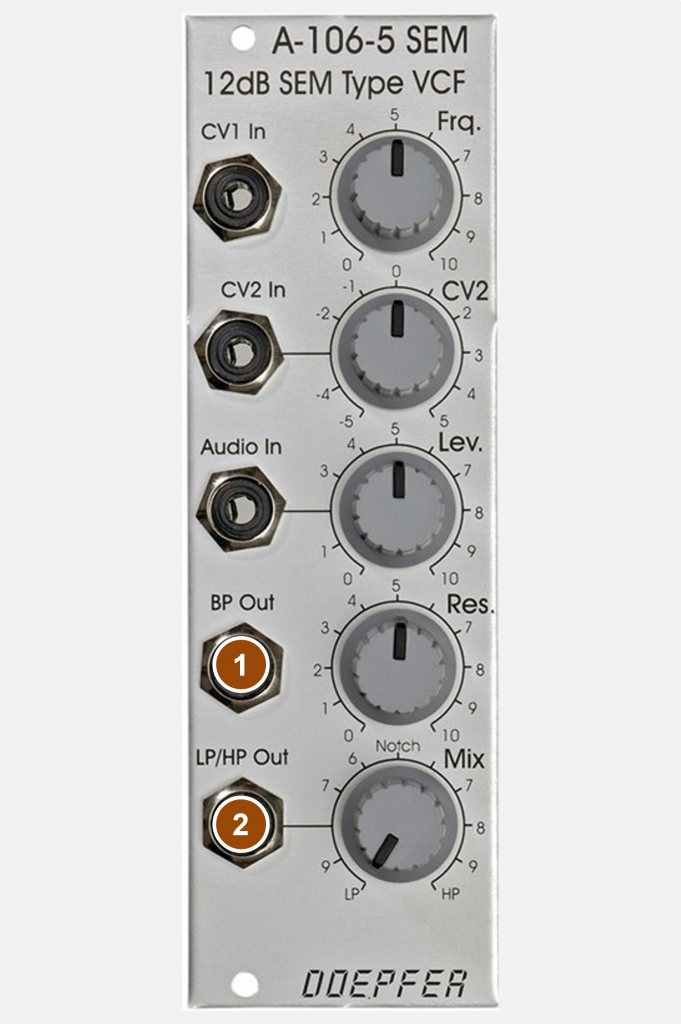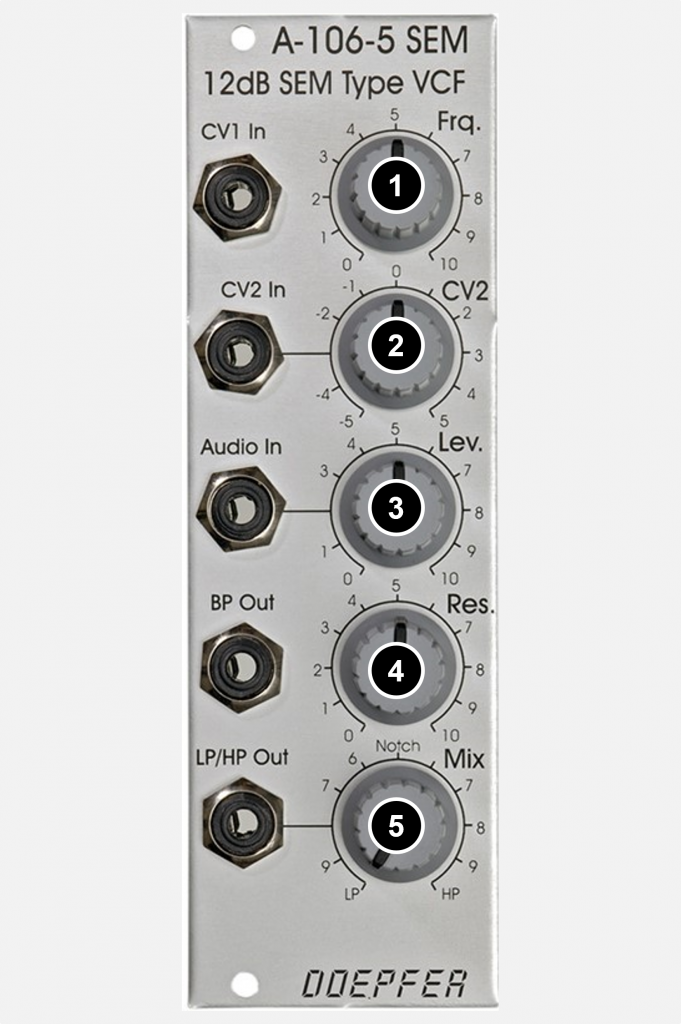The A-106-5 is a 12dB filter with two separate outputs for lowpass / notch / highpass (crossfade) and for bandpass. The filter is inspired by the Oberheim SEM filter. Incidentally, “SEM” stood for “Synthesizer Expander Module”, the SEM in 1974 was a small box without its own keyboard and originally intended to supplement a “normal” synthesizer such as the Minimoog.
By the way, the A-124 Wasp Filter has quite the same options and possibilities, but a slightly different front panel layout. Otherwise, the two filters sound very different, so that they result in a nice combination of the very “flattering” SEM and the “harsh” Wasp.
User interface
Inputs:

- CV1 In: Control voltage input for controlling the cutoff-frequency (without attenuator).
- CV2 In: Control voltage input for cutoff-frequency control (with bipolar attenuator).
- Audio In: Audio input.
Outputs:

- BP Out: Output for the bandpass filtered signal.
- LP / HP Out: Output for the lowpass, notch or highpass filtered signal (with “Mix” fader).
Controls:

- Frq.: Controller for the cutoff-frequency, affects all filter modes.
- CV2: Attenuator for the control voltage input “CV2 In”. The controller works bipolar, i.e. the input signal is inverted at controller positions to the left of “12 o’clock” (only a simple attenuator is used here with the A-124, which is otherwise functionally comparable).
- Lev.: Attenuator for the audio input.
- Res.: Controller for the resonance of the filter. Self-oscillation is not achieved.
- Mix: Fader for the filter modes, from Lowpass to Notch to Highpass. Only changes the signal at the “LP / HP Out” output, the “BP Out” output remains unaffected.
Beautiful, classic, round
The SEM filter is ideal if you are looking for a “nice” sounding, versatile filter. Well suited e.g. for classic sequencer lines, which should not lose their bass component even with higher resonance.
Rapid changes in the cutoff frequency produce sounds very similar to a filter’s self-oscillation (the SEM filter is otherwise incapable of self-oscillation).
Special edition
A special edition of the A-106-5 is available with a cream front panel and black knobs instead of grey.
Sound examples
-
A-106-5 / Crossfading the filter modes
In this example, the sawtooth outputs of three A-110-1 VCOs are used, with one VCO transposed down an octave. The VCOs are controlled by an A-155 sequencer, the A-106-5 filter is modulated by an A-140 ADSR envelope and a slow sine LFO.
We start without any resonance, I manually fade from low-pass to notch to high-pass. Following this, an A-134-1 VC panning/crossfader is used to crossfade from the LP/HP output to the bandpass. Now the resonance of the filter is increased to the maximum. Then we hear the HP/LP output again, I regulate again from the highpass via notch to the lowpass mode and reduce the resonance back to zero.
Crossfading the filter modes. -
A-106-5 / Filter Ringing
Although the SEM filter is not suitable for self-resonance, it can be used with a fast modulation source in a control voltage input to generate what is known as “filter ringing”.
First we hear an A-106-5 filter (no input signal) through an A-132-3 VCA with constant gain, the VCA’s gain control is turned to maximum. As expected, as we increase the filter resonance we hear no self-oscillation, just some background hiss (which has been adjusted much louder here than we would hear in a real patch). I then add an A-140 ADSR as the filter cutoff modulation source and we hear the resulting crackling, noisy tones. Finally the VCA is switched from constant gain to modulation by the same A-140.
Filter Ringing.
Technical specifications
| Width | 8 HP |
| Depth | 55 mm |
| Power requirements | 30 mA (+12V) / -20 mA (-12V) |
